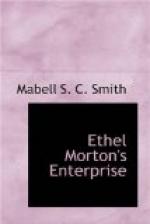“We’ve decided on ageratum for the border and larkspur and monkshood for the back,” said Ethel Brown.
“There are blue crocuses and hyacinths and ‘baby’s breath’ for your earliest blossoms, and blue columbines as well as pink and yellow ones! and blue morning glories for your ‘climber,’ and blue bachelors’ buttons and Canterbury bells, and mourning bride, and pretty blue lobelia for low growing plants and blue lupine for a taller growth. If you are willing to depart from real blue into violet you can have heliotrope and violets and asters and pansies and primroses and iris.”
“The wild flag is fairly blue,” insisted Roger, who was familiar with the plants that edged the brook on his grandfather’s farm.
“It is until you compare it with another moisture lover—forget-me-not.”
“If Dorothy buys the Clarks’ field she can start a colony of flags and forget-me-nots in the stream,” suggested James.
“Can you remember cineraria? There’s a blue variety of that, and one of salpiglossis, which is an exquisite flower in spite of its name.”
“One of the sweetpea packages is marked ‘blue,’” said Roger, “I wonder if it will be a real blue?”
“Some of them are pretty near it. Now this isn’t a bad list for a rather difficult color,” Mr. Emerson went on, looking over Ethel Blue’s paper, “but you can easily see that there isn’t the variety of the pink list and that the true blues are scarce.”
“We’re going to try it, anyway,” returned Helen. “Perhaps we shall run across some others. Now I wrote down for the yellows, yellow crocuses first of all and yellow tulips.”
“There are many yellow spring flowers and late summer brings goldenrod, so it seems as if the extremes liked the color,” said Margaret observantly.
“The intermediate season does, too,” returned Mr. Emerson.
“Daffodils and jonquils are yellow and early enough to suit the most impatient,” remarked James.
“Who wrote this,” asked Mr. Emerson, from whom Ethel Brown inherited her love of poetry:
“I wandered lonely as
a cloud
That floats on high on vales
and hills,
When all at once I saw a crowd
A host of golden daffodils;
Beside the lake, beneath the
trees,
Fluttering and dancing in
the breeze.”
“Wordsworth,” cried Ethel Brown.
“Wordsworth,” exclaimed Tom Watkins in the same breath.
“That must mean that daffies grow wild in England,” remarked Dorothy.
“They do, and we can have something of the same effect here if we plant them through a lawn. The bulbs must be put in like other bulbs, in the autumn. Crocuses may be treated in the same way. Then in the spring they come gleaming through the sod and fill everybody with Wordsworth’s delight.”
“Here’s another competition between Helen’s wild garden and the color bed; which shall take the buttercups and cowslips?”




